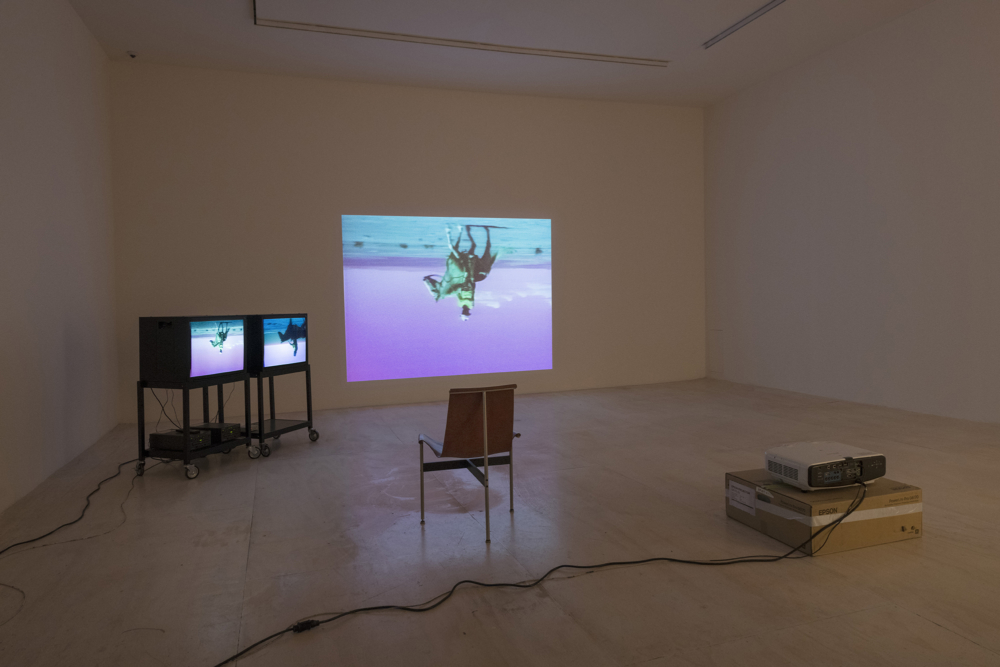Bruce Nauman’s Blissful Boredom

“Contrapposto Studies i through vii,” 2015/16. Video by Bruce Nauman.
Walking into a dark room at the PS1 segment of the Bruce Nauman retrospective, one comes across a simple black-and-white video of the artist combing his pubic hair. While staring at the grainy 16mm footage of Black Balls, I eavesdropped on a young boy, watching alongside me, who asked his father, “But why’s he doing that, dad? Why?” Too stunned by this child’s desperation, I missed the father’s response. What would I have told him? It’s an ancient practice that old men use in New Mexico. Seriously, though. Why?
Fortunately for us, children and adults alike, Nauman vaporized the “why” from his practice long ago. Its absence hovers over “Disappearing Acts,” the largest retrospective of Nauman’s collected works to date, spread across both the Museum of Modern Art in New York and its Long Island City outpost, PS1. Instead of those perilously large questions of art and audience, there’s a sense that one comes to Nauman’s work, as Roberta Smith once wrote, simply to “endure it.” In a universe of pieces guided by Nauman’s minimal gospel of “just do,” what else can one do?
The video works in “Disappearing Acts” are something like the grand finale in a confrontation that Nauman has engaged in for over 30 years, working alone in his New Mexico studio. A confrontation every artists dreads: the void of self. In his self-imposed desert exile, Nauman has activated this void and, like the ranch hand he’s become, tamed it. Using almost any possible medium (sculpture, photography, neon lighting, video, drawing, printmaking, and performance) Nauman plays with it as he sees fit—through amplification, distortion, bulk documentation. In his hands, it’s transformed into his own markers of time and existence. The resulting sounds, images, and videos are monuments to the tectonic energy of boredom. But elsewhere, as in 2017’s Contrapposto Split, a 3D video of Nauman pacing his studio floor, he lassos us into his solitude. Wait, is Nauman taming us now?

“Green Horses,” 1988. Video by Bruce Nauman.
It’s said that boredom is often a necessary level to attain higher enlightenment. I’m thinking of a Hare Krishna’s infinitive repetition of their mantra, or the romantic notion of cultivated boredom from which stems great inspiration. The single shot film of Nauman, the ranch hand, building a fence corner under the New Mexico sun for 59 uninterrupted minutes in Setting a Good Corner (Allegory and Metaphor) is just one example of Nauman’s many infinitive repetitions. For Nauman, these vacuums of his documented boredom present themselves as a test. “This is fun. I’m bored. You’re bored. We’re bored. Life is boring. I’m boring,” chime the dueling talking heads in Nauman’s Good Boy Bad Boy. At every point in “Disappearing Acts,” I sense that he wants to test impatience, and harvest the anxiety to fertilize his work. In his videos, Nauman’s lens is on the prowl for the original state, an ultimate archaic solitude at the dawn of imagination, and his work demands that we follow to that moment when society wasn’t structured, when politics didn’t exist, when the first man woke up, shivering, anxious, as he’s realized the fate of the human condition.
“You can recognize a Nauman by the way it makes you want to go home,” the art critic Andrew Salomon said of the artist’s explorations of life’s gray matter. And why not go home? Why bother with Nauman’s stimulating discomforts and neon anxieties? Why stay? Why is he combing his pubic hair on video? What would it mean to tame the solitude that waits for all of us? If I could answer any of these questions, I probably wouldn’t have come at all.






